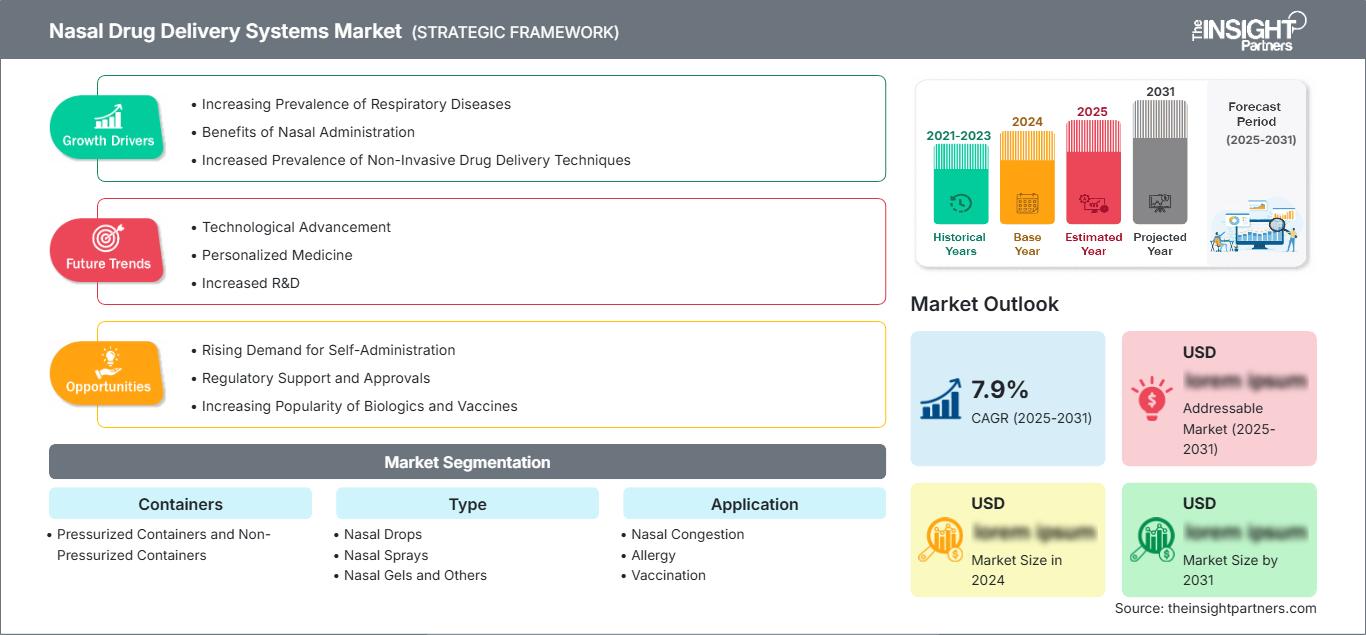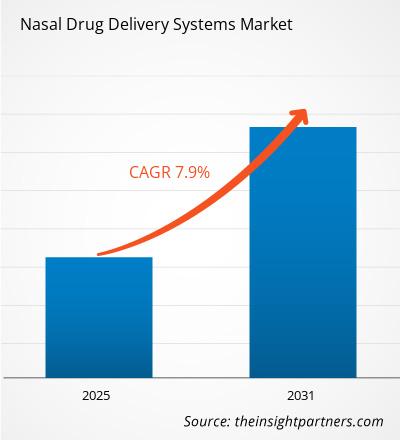Le marché des systèmes d'administration nasale de médicaments devrait atteindre 89,03 milliards de dollars américains d'ici 2031. Il devrait enregistrer un TCAC de 6,2 % entre 2025 et 2031.
Le rapport est segmenté par type de contenant (contenants pressurisés et non pressurisés), type (gouttes nasales, sprays nasaux, gels nasaux et autres) et application (congestion nasale, allergies, vaccination, rhinite et autres). L'analyse mondiale est également détaillée au niveau régional et par principaux pays. Le rapport présente les valeurs en dollars américains pour les analyses et segments mentionnés ci-dessus.
Objectif du rapport
Le rapport sur le marché des systèmes d'administration nasale de médicaments, réalisé par The Insight Partners, vise à décrire le paysage actuel et la croissance future, les principaux facteurs de croissance, les défis et les opportunités. Cela permettra d'éclairer divers acteurs économiques, tels que :
- Fournisseurs de technologies/Fabricants : Pour comprendre l'évolution de la dynamique du marché et identifier les opportunités de croissance potentielles, afin de prendre des décisions stratégiques éclairées.
- Investisseurs : Pour réaliser une analyse approfondie des tendances concernant le taux de croissance du marché, les projections financières et les opportunités tout au long de la chaîne de valeur.
- Organismes de réglementation : Pour encadrer les politiques et les activités du marché afin de minimiser les abus, préserver la confiance des investisseurs et garantir l'intégrité et la stabilité du marché.
Segmentation du marché des systèmes d'administration nasale de médicaments : Contenants
- Contenants pressurisés et non pressurisés
Type
- Gouttes nasales
- Sprays nasaux
- Gels nasaux et autres
Application
- Congestion nasale
- Allergies
- Vaccination
- Rhinite et autres
Répartition géographique
- Amérique du Nord
- Europe
- Asie-Pacifique
- Amérique du Sud et centrale
- Moyen-Orient et Afrique
Vous bénéficierez d’une personnalisation sur n’importe quel rapport - gratuitement - y compris des parties de ce rapport, ou une analyse au niveau du pays, un pack de données Excel, ainsi que de profiter d’offres exceptionnelles et de réductions pour les start-ups et les universités
Marché des systèmes d'administration nasale de médicaments: Perspectives stratégiques

-
Obtenez les principales tendances clés du marché de ce rapport.Cet échantillon GRATUIT comprendra une analyse de données, allant des tendances du marché aux estimations et prévisions.
Facteurs de croissance du marché des systèmes d'administration nasale de médicaments
- Prévalence croissante des maladies respiratoires : La forte prévalence des maladies respiratoires, notamment l'asthme, la BPCO, la rhinite allergique et la sinusite, contribue fortement à l'augmentation de l'incidence de ces maladies et, par conséquent, engendre une forte hausse de la demande en systèmes d'administration nasale de médicaments efficaces pour cibler les traitements appropriés.
- Avantages de l'administration nasale : L'administration nasale permet une absorption rapide et une diffusion directe du médicament dans la circulation systémique ou au niveau local, ce qui permet d'obtenir des effets thérapeutiques plus rapides et de meilleurs résultats pour les patients. Étant donné la prévalence des affections aiguës et des maladies chroniques qui nécessitent un soulagement immédiat, il s'agit d'une méthode d'administration de médicaments importante.
- Prévalence accrue des techniques d'administration de médicaments non invasives : L'administration nasale est moins invasive et, de ce fait, les patients la préfèrent aux injections. Cela peut améliorer l'observance thérapeutique, en particulier chez les patients qui ont peur des aiguilles. L'administration nasale est perçue comme plus pratique et moins douloureuse que l'administration invasive de médicaments, améliorant ainsi l'observance du traitement.
Tendances futures du marché des systèmes d'administration nasale de médicaments
- Progrès technologiques : Les technologies de formulation liées aux progrès réalisés dans le domaine des nanoparticules, des micro-aiguilles et d'autres systèmes d'administration de médicaments avancés améliorent l'efficacité de l'administration nasale. L'essor des systèmes d'administration intelligents, notamment les sprays nasaux intelligents et les systèmes à libération contrôlée avec capteurs intégrés et déclenchement technologique de la libération des médicaments, devrait stimuler la croissance du marché.
- Médecine personnalisée : Les systèmes d'administration nasale s'inscrivent dans la tendance à la médecine personnalisée, qui consiste à développer des systèmes d'administration de médicaments adaptés à chaque individu et patient. La convergence constante des secteurs de la santé et des biotechnologies est une forme d'interaction qui devrait engendrer des changements en médecine personnalisée et en administration nasale de médicaments.
- Investigation accrue en R&D : L'industrie pharmaceutique investit de plus en plus dans la R&D de formulations et de dispositifs nasaux innovants. Les niveaux de biodisponibilité sont constamment améliorés et des traitements ciblés pour les affections respiratoires sont mis en œuvre. De ce fait, de nombreux nouveaux produits font leur apparition sur le marché.
Opportunités du marché des systèmes d'administration nasale de médicaments
- Demande croissante d'auto-administration : La tendance à l'auto-administration des traitements donne un élan indispensable au marché de l'administration nasale de médicaments, notamment pour les affections chroniques nécessitant un traitement à long terme. Là encore, cela se traduira par la mise sur le marché de sprays et de dispositifs nasaux en vente libre.
- Soutien réglementaire et approbations : Les autorités réglementaires ont adopté une approche favorable aux nouvelles formulations de médicaments et de systèmes d'administration. Il en résulte une accélération des délais d'approbation et une mise sur le marché plus rapide des nouveaux médicaments nasaux. Ce soutien réglementaire accru a également un impact positif sur l'environnement d'approbation des formulations de médicaments nasaux.
- Popularité croissante des produits biologiques et des vaccins : L'administration nasale connaît une croissance soutenue dans le domaine des médicaments biologiques et des vaccins. L'administration nasale améliore l'observance thérapeutique, tandis que la voie d'administration invasive des vaccins est éliminée. Dans le cas des produits biologiques, tels que les anticorps monoclonaux et les peptides, développés pour cibler des maladies spécifiques, notamment le cancer et les maladies auto-immunes, l'administration nasale de ces médicaments améliore leur acceptabilité et l'observance du traitement.
Marché des systèmes d'administration de médicaments par voie nasale
Les analystes de The Insight Partners ont analysé en détail les tendances régionales et les facteurs influençant le marché des systèmes d'administration nasale de médicaments tout au long de la période prévisionnelle. Cette section aborde également les segments et la répartition géographique du marché de la gestion des troubles du rythme cardiaque en Amérique du Nord, en Europe, en Asie-Pacifique, au Moyen-Orient et en Afrique, ainsi qu'en Amérique du Sud et centrale.
Portée du rapport sur le marché des systèmes d'administration nasale de médicaments
| Attribut de rapport | Détails |
|---|---|
| Taille du marché en 2024 | US$ XX Billion |
| Taille du marché par 2031 | US$ 89.03 Billion |
| TCAC mondial (2025 - 2031) | 6.2% |
| Données historiques | 2021-2023 |
| Période de prévision | 2025-2031 |
| Segments couverts |
By Conteneurs
|
| Régions et pays couverts |
Amérique du Nord
|
| Leaders du marché et profils d'entreprises clés |
|
Densité des acteurs du marché des systèmes d'administration nasale de médicaments : comprendre son impact sur la dynamique commerciale
Le marché des systèmes d'administration nasale de médicaments connaît une croissance rapide, portée par une demande croissante des utilisateurs finaux, elle-même alimentée par l'évolution des préférences des consommateurs, les progrès technologiques et une meilleure connaissance des avantages du produit. Face à cette demande grandissante, les entreprises élargissent leur offre, innovent pour répondre aux besoins des consommateurs et tirent parti des tendances émergentes, ce qui stimule davantage la croissance du marché.

- Obtenez le Marché des systèmes d'administration nasale de médicaments Aperçu des principaux acteurs clés
Points clés de vente
- Couverture exhaustive : Ce rapport analyse en détail les produits, services, types et utilisateurs finaux du marché des systèmes d’administration nasale de médicaments, offrant ainsi une vision globale.
- Analyse d’experts : Ce rapport repose sur une connaissance approfondie du secteur et des analystes.
- Informations actualisées : Grâce à sa couverture des informations et tendances les plus récentes, ce rapport garantit la pertinence de vos analyses.
- Options de personnalisation : Ce rapport peut être personnalisé pour répondre aux besoins spécifiques de vos clients et s’adapter parfaitement à leurs stratégies commerciales.
Ce rapport d’étude de marché sur les systèmes d’administration nasale de médicaments peut donc vous aider à décrypter et comprendre le contexte sectoriel et les perspectives de croissance. Malgré quelques points à améliorer, les avantages de ce rapport l’emportent généralement sur les inconvénients.
- Analyse historique (2 ans), année de base, prévision (7 ans) avec TCAC
- Analyse PEST et SWOT
- Taille du marché Valeur / Volume - Mondial, Régional, Pays
- Industrie et paysage concurrentiel
- Ensemble de données Excel
Rapports récents
Rapports connexes
Témoignages
Raison d'acheter
- Prise de décision éclairée
- Compréhension de la dynamique du marché
- Analyse concurrentielle
- Connaissances clients
- Prévisions de marché
- Atténuation des risques
- Planification stratégique
- Justification des investissements
- Identification des marchés émergents
- Amélioration des stratégies marketing
- Amélioration de l'efficacité opérationnelle
- Alignement sur les tendances réglementaires






















 Obtenez un échantillon gratuit pour - Marché des systèmes d'administration nasale de médicaments
Obtenez un échantillon gratuit pour - Marché des systèmes d'administration nasale de médicaments